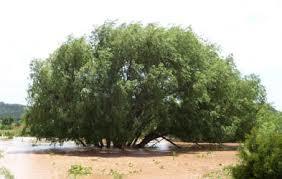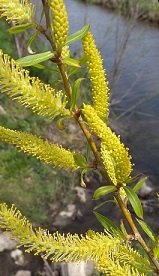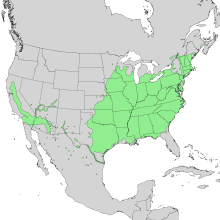Black Willow: Difference between revisions
No edit summary |
|||
| (2 intermediate revisions by one other user not shown) | |||
| Line 7: | Line 7: | ||
[[File:Bl_willow1.jpg|200px|thumb|left]] ''Salix nigra'' is a deciduous tree species that excels in areas of high moisture content such as swamps, river banks, and drainage ditches. It can grow almost anywhere that contains adequate lighting and water. These locations usually occur in areas that are near or just below the water level. It is a fast-growing, yet short-lived, tree that has an extensive range through Eastern North America as well as parts of California and the Southwest. It can grow from 30 to 60 feet tall on a single or multiple trunks, with a crown spread of 30 to 60 feet. Under the best conditions, Salix nigra has been known to reach heights of 140 feet. The leaves are up to 6 inches long, tapering at the end, are medium to dark green, and fine-toothed. The bark is dark brown and rough in texture. [14] Black willow trees are a dioecious species, meaning the males and females appear as separate trees. The flowering season begins in February in the southern range and goes through the end of June in the north. The blooms are tiny (about 2 inches long), insignificant, and yellow to green in color. [14] The flowers contain nectar meaning that the majority of the pollination process is done by [[insects]]. The pollen can still be carried by the wind as well. The seeds of ''Salix nigra'' are small, light brown to yellow, have a capsule shape, and begin to break open and release seedlings that are coated in little hairs. | [[File:Bl_willow1.jpg|200px|thumb|left]] ''Salix nigra'' is a deciduous tree species that excels in areas of high moisture content such as swamps, river banks, and drainage ditches. It can grow almost anywhere that contains adequate lighting and water. These locations usually occur in areas that are near or just below the water level. It is a fast-growing, yet short-lived, tree that has an extensive range through Eastern North America as well as parts of California and the Southwest. It can grow from 30 to 60 feet tall on a single or multiple trunks, with a crown spread of 30 to 60 feet. Under the best conditions, Salix nigra has been known to reach heights of 140 feet. The leaves are up to 6 inches long, tapering at the end, are medium to dark green, and fine-toothed. The bark is dark brown and rough in texture. [14] Black willow trees are a dioecious species, meaning the males and females appear as separate trees. The flowering season begins in February in the southern range and goes through the end of June in the north. The blooms are tiny (about 2 inches long), insignificant, and yellow to green in color. [14] The flowers contain nectar meaning that the majority of the pollination process is done by [[insects]]. The pollen can still be carried by the wind as well. The seeds of ''Salix nigra'' are small, light brown to yellow, have a capsule shape, and begin to break open and release seedlings that are coated in little hairs. | ||
[[File:Salix_nigra_range_map_1.png|250px|thumb|right]] | [[File:Salix_nigra_range_map_1.png|250px|thumb|right]] | ||
== Classification == | == Classification == | ||
*Kingdom- Plantae (Plant) | *Kingdom- [[Plantae]] (Plant) | ||
**Subkingdom- Viridiplantae (Green Plants) | **Subkingdom- Viridiplantae (Green Plants) | ||
***Infrakingdom- Streptophyta (Land Plants) | ***Infrakingdom- Streptophyta (Land Plants) | ||
| Line 26: | Line 29: | ||
== Ecological Significance == | == Ecological Significance == | ||
Various different | Various different vertebrate [[animals]] rely on the Black Willows as a food source or as a provider of protective habitat. Both the Snapping Turtle (Chelydra serpentina) and Wood Turtle (Clemmys insculpta) feed on fallen willow leaves. The Ruffed Grouse, White-throated Sparrow, and waterfowl species such as the Mallard and Northern Pintail feed on willow buds during the spring when their other food sources are a little more scarce. Some birds, including the Rusty Grackle, Yellow Warbler, and Warbling Vireo occasionally use willows as the location for their nests. Black Willows also happen to be one of the tree species that the Yellow-Bellied Sapsucker drills holes into in order to feed on the sap. Deer, elk, and cattle are known to browse occasionally on the leaves and twigs of this tree, while beavers feed on the wood and use the branches in the construction of their dams and lodges. | ||
They are tolerant of floods, herbivory, and erosion, making them good trees to grow on shore banks to prevent [[soil erosion]] and increase marshland stability. | They are tolerant of floods, herbivory, and erosion, making them good trees to grow on shore banks to prevent [[soil erosion]] and increase marshland stability. | ||
| Line 32: | Line 35: | ||
== Cultural Uses == | == Cultural Uses == | ||
''Salix nigra'' is very useful for treating minor aches and pains, as it contains salicin, the primary ingredient in aspirin. The wood of the Black Willow is the most commercially used of the different species of willow for its strength, shock resistance, light weight, and | ''Salix nigra'' is very useful for treating minor aches and pains, as it contains salicin, the primary ingredient in aspirin. The wood of the Black Willow is the most commercially used of the different species of willow for its strength, shock resistance, light weight, and the fact that it doesn’t splinter that easily. It’s mostly used in the construction of boxes, crates, and furniture as well as woodturning, table tops, wood carvings, etc. It is the only native willow species in the United States to be used as timber. | ||
Historically, it was used by Native Americans to make baskets as well as treat fevers, headaches, and coughs. They also recognized that the bark and the leaves could be used to treat rheumatism. | Historically, it was used by Native Americans to make baskets as well as treat fevers, headaches, and coughs. They also recognized that the bark and the leaves could be used to treat rheumatism. | ||
== Soil Restoration Techniques == | == Soil Restoration Techniques == | ||
[[File:Live_staking.jpg|300px|thumb|right]] | |||
In addition to all the cultural uses for this species, the ways in which this willow species can remove heavy metals from the [[soil]] are being studied. They are starting to be used in remediation efforts, and the [[endophytes]] that are living within the tree's tissues have shown to have the capacity to enhance the tree's growth. These trees also possess a resistance to biotic and abiotic stressors like that of [[nitrogen fixation]] and the production of phytohormones. Mercury and selenium can also be converted by ''Salix nigra'' into a volatile form to release and dilute into the atmosphere. Black willows are very effective when it comes to soil stabilization, which is why many projects that require erosion control such as river restoration will often use this species in their efforts. | In addition to all the cultural uses for this species, the ways in which this willow species can remove heavy metals from the [[soil]] are being studied. They are starting to be used in remediation efforts, and the [[endophytes]] that are living within the tree's tissues have shown to have the capacity to enhance the tree's growth. These trees also possess a resistance to biotic and abiotic stressors like that of [[nitrogen fixation]] and the production of phytohormones. Mercury and selenium can also be converted by ''Salix nigra'' into a volatile form to release and dilute into the atmosphere. Black willows are very effective when it comes to soil stabilization, which is why many projects that require erosion control such as river restoration will often use this species in their efforts. | ||
== References == | == References == | ||
1. https://www.ernstseed.com/products/bioengineering-materials/ | 1. Ernest Seeds. 2023. Bioengineering Materials. Ernest Conservation Seeds. https://www.ernstseed.com/products/bioengineering-materials/ | ||
2. http://www.illinoiswildflowers.info/trees/plants/bl_willow.htm | 2. Illinois Wildflowes. 2002. Black Willow. John Hilty. http://www.illinoiswildflowers.info/trees/plants/bl_willow.htm | ||
3. Eyre, F. H., ed. 1980. Forest cover types of the United States and Canada. Society of American Foresters, Washington, DC. 148 p. | 3. Eyre, F. H., ed. 1980. Forest cover types of the United States and Canada. Society of American Foresters, Washington, DC. 148 p. | ||
| Line 66: | Line 69: | ||
11. Article homeguides.sfgate.com/willow-tree-fungus | 11. Article homeguides.sfgate.com/willow-tree-fungus | ||
12. http://www.sisef.it/iforest/contents/?id=ifor0555-004 | 12. Mauricio Capuana. 2011. Heavy Metals and Woody Plants-Biotechnologies for [[Phytoremediation]]. IForest Biogeosciences and Forestry 4(1): 7-15. http://www.sisef.it/iforest/contents/?id=ifor0555-004 | ||
13. http://ontariotrees.com/main/species.php?id=2230 | 13. Walter Muma. Black Willow. Ontario Trees and Shrubs. http://ontariotrees.com/main/species.php?id=2230 | ||
14. https://www.missouribotanicalgarden.org/PlantFinder/PlantFinderDetails.aspx?taxonid=286793 | 14. Missouri Botanical Garden. 2023. Salix nigra. Missouri Botanical Garden. https://www.missouribotanicalgarden.org/PlantFinder/PlantFinderDetails.aspx?taxonid=286793 | ||
Latest revision as of 11:53, 12 May 2023

Overview

Salix nigra is a deciduous tree species that excels in areas of high moisture content such as swamps, river banks, and drainage ditches. It can grow almost anywhere that contains adequate lighting and water. These locations usually occur in areas that are near or just below the water level. It is a fast-growing, yet short-lived, tree that has an extensive range through Eastern North America as well as parts of California and the Southwest. It can grow from 30 to 60 feet tall on a single or multiple trunks, with a crown spread of 30 to 60 feet. Under the best conditions, Salix nigra has been known to reach heights of 140 feet. The leaves are up to 6 inches long, tapering at the end, are medium to dark green, and fine-toothed. The bark is dark brown and rough in texture. [14] Black willow trees are a dioecious species, meaning the males and females appear as separate trees. The flowering season begins in February in the southern range and goes through the end of June in the north. The blooms are tiny (about 2 inches long), insignificant, and yellow to green in color. [14] The flowers contain nectar meaning that the majority of the pollination process is done by insects. The pollen can still be carried by the wind as well. The seeds of Salix nigra are small, light brown to yellow, have a capsule shape, and begin to break open and release seedlings that are coated in little hairs.

Classification
- Kingdom- Plantae (Plant)
- Subkingdom- Viridiplantae (Green Plants)
- Infrakingdom- Streptophyta (Land Plants)
- Superdivision- Embryophyta (Land Plants)
- Division- Tracheophyta (Vascular Plants)
- Subdivision- Spermatophytina (Seed Plants)
- Class- Magnoliopsida (Flowering Dicots)
- Superorder- Rosanae (Flowering Plants)
- Order- Malpighiales (Flowering Plants)
- Family- Salicaceae (Willows)
- Genus- Salix (Willows)
- Species- Salix nigra (Black Willow)
- Genus- Salix (Willows)
- Family- Salicaceae (Willows)
- Order- Malpighiales (Flowering Plants)
- Superorder- Rosanae (Flowering Plants)
- Class- Magnoliopsida (Flowering Dicots)
- Subdivision- Spermatophytina (Seed Plants)
- Division- Tracheophyta (Vascular Plants)
- Superdivision- Embryophyta (Land Plants)
- Infrakingdom- Streptophyta (Land Plants)
- Subkingdom- Viridiplantae (Green Plants)
Ecological Significance
Various different vertebrate animals rely on the Black Willows as a food source or as a provider of protective habitat. Both the Snapping Turtle (Chelydra serpentina) and Wood Turtle (Clemmys insculpta) feed on fallen willow leaves. The Ruffed Grouse, White-throated Sparrow, and waterfowl species such as the Mallard and Northern Pintail feed on willow buds during the spring when their other food sources are a little more scarce. Some birds, including the Rusty Grackle, Yellow Warbler, and Warbling Vireo occasionally use willows as the location for their nests. Black Willows also happen to be one of the tree species that the Yellow-Bellied Sapsucker drills holes into in order to feed on the sap. Deer, elk, and cattle are known to browse occasionally on the leaves and twigs of this tree, while beavers feed on the wood and use the branches in the construction of their dams and lodges.
They are tolerant of floods, herbivory, and erosion, making them good trees to grow on shore banks to prevent soil erosion and increase marshland stability.
Cultural Uses
Salix nigra is very useful for treating minor aches and pains, as it contains salicin, the primary ingredient in aspirin. The wood of the Black Willow is the most commercially used of the different species of willow for its strength, shock resistance, light weight, and the fact that it doesn’t splinter that easily. It’s mostly used in the construction of boxes, crates, and furniture as well as woodturning, table tops, wood carvings, etc. It is the only native willow species in the United States to be used as timber.
Historically, it was used by Native Americans to make baskets as well as treat fevers, headaches, and coughs. They also recognized that the bark and the leaves could be used to treat rheumatism.
Soil Restoration Techniques

In addition to all the cultural uses for this species, the ways in which this willow species can remove heavy metals from the soil are being studied. They are starting to be used in remediation efforts, and the endophytes that are living within the tree's tissues have shown to have the capacity to enhance the tree's growth. These trees also possess a resistance to biotic and abiotic stressors like that of nitrogen fixation and the production of phytohormones. Mercury and selenium can also be converted by Salix nigra into a volatile form to release and dilute into the atmosphere. Black willows are very effective when it comes to soil stabilization, which is why many projects that require erosion control such as river restoration will often use this species in their efforts.
References
1. Ernest Seeds. 2023. Bioengineering Materials. Ernest Conservation Seeds. https://www.ernstseed.com/products/bioengineering-materials/
2. Illinois Wildflowes. 2002. Black Willow. John Hilty. http://www.illinoiswildflowers.info/trees/plants/bl_willow.htm
3. Eyre, F. H., ed. 1980. Forest cover types of the United States and Canada. Society of American Foresters, Washington, DC. 148 p.
4. Johnson, R. L., and J. S. McKnight. 1969. Benefits from thinning black willow. USDA Forest Service, Research Note SO-89. Southern Forest Experiment Station, New Orleans, LA. 6 p. Little, Elbert L., Jr. 1979. Checklist of United States trees (native and naturalized). U.S. Department of Agriculture, Agriculture Handbook 541. Washington, DC. 375 p.
5. McKnight, J. S. 1965. Black willow (Salix nigra Marsh.). In Silvics of forest trees of the United States. p. 650-652. H. A. Fowells, comp. U.S. Department of Agriculture, Agriculture Handbook 271. Washington, DC.
6. McLeod, K. W., and J. K. McPherson. 1972. Factors limiting the distribution of Salix nigra. Bulletin of the Torrey Botanical Club 100(2):102-110.
7. Randall, W. K. 1971. Willow clones differ in susceptibility to cottonwood leaf beetle. In Proceedings, Eleventh Southern Forest Tree Improvement Conference. Southern Forest Tree Improvement Committee Sponsored Publication 33. p. 108-111. Eastern Tree Seed Laboratory, Macon, GA.
8. Sakai, A., and C. J. Wiser. 1973. Freezing resistance of trees in North America with reference to tree regions. Ecology 54(l):118-126.
9. Taylor, F. W. 1975. Wood property differences between two stands of sycamore and black willow. Wood and Fiber 7(3):187-191.
10. Vines, Robert A. 1960. Trees, shrubs and woody vines of the Southwest. University of Texas Press Austin 1104 p.
11. Article homeguides.sfgate.com/willow-tree-fungus
12. Mauricio Capuana. 2011. Heavy Metals and Woody Plants-Biotechnologies for Phytoremediation. IForest Biogeosciences and Forestry 4(1): 7-15. http://www.sisef.it/iforest/contents/?id=ifor0555-004
13. Walter Muma. Black Willow. Ontario Trees and Shrubs. http://ontariotrees.com/main/species.php?id=2230
14. Missouri Botanical Garden. 2023. Salix nigra. Missouri Botanical Garden. https://www.missouribotanicalgarden.org/PlantFinder/PlantFinderDetails.aspx?taxonid=286793